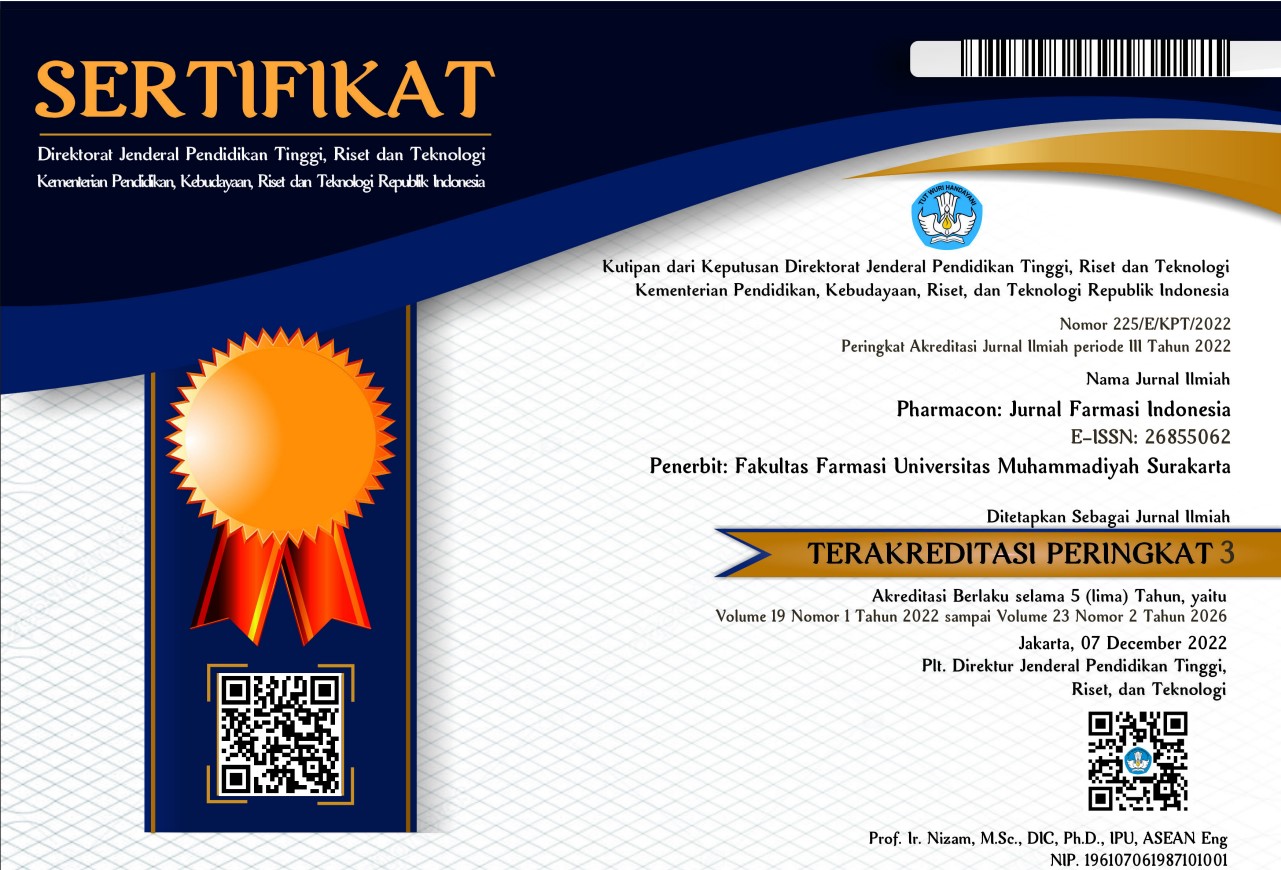Effect of Different Solvents on Toxicity and Secondary Metabolites of Mangkokan Leaves (Polyscias scutellaria (Burm.f.) Fosberg) by Brine Shrimp Lethality Test (BSLT) Method
Keywords:
Artemia salina Leach; BSLT; leaf bowl; LC50; Polyscias scutellaria (Burm.f.) FosbergAbstract
Mangkokan (Polyscias scutellaria (Burm.f.) Fosberg) is one of the plants belonging to the Araliaceae family. Empirically, mangkokan plants, especially the leaves, are used by the community as traditional
medicine. Mangkokan leaves need to be developed into a source of natural materials such as biopesticides, biolarvicide, and anticancer agents because they have toxic compounds. Secondary metabolite compounds of mangkokan leaves consist of flavonoids, saponins, monoterpenes-sesquiterpenes, and steroids. This study aims to determine the toxicity of n-hexane, ethyl acetate, and ethanol extracts of mangkokan leaves using the Brine Shrimp Lethality Test (BSLT) method. Mangkokan leaves were extracted by graded maceration method using n-hexane, ethyl acetate, and 96% ethanol solvents. All three extracts were tested BSLT on Artemia salina larva test animals. The toxicity level is expressed by the LC50 value obtained from the probit analysis. The LC50 value of n-hexane, ethyl acetate, and ethanol extracts was 146.724 μg/mL, respectively; 66.029 μg/mL; and 92.007 μg/mL. The results showed that all three extracts were toxic.
References
Abriyani, E., Yuniarsih, N., Fikayuniar, Li., & Sulastri, D. (2022). Phytochemical Screening of Telang Flower Leaf Extract (Clitoria ternatea L) and Toxicity Test on Artemia Salina Shrimp Larvae Using the Bslt Method. Journal of Pharmacopolium, 5(2), 220–222. https://doi.org/10.36465/jop.v5i2.902
Baud, G. S., Sangi, M. S., & Koleangan, H. S. J. (2014). Secondary Metabolite Compound Analysis and Toxicity Test of Ethanol Extract of Broken Bone Plant Stem (Euphorbia tirucalli L.) Using the Brine Shrimp Lethality Test (BSLT) Method. Jurnal Ilmiah Sains, 14(2), 1–8. https://doi.org/10.35799/jis.14.2.2014.6065
Hanum, G. R., & Ardiansyah, S. (2017). Mangkokan Extract Soap (Nothopanax scutellaium Merr.) As Antibacterial Against Staphylococcus aureus. STIGMA: Jurnal Matematika Dan Ilmu Pengetahuan Alam Unipa, 10(01), 36–39. https://doi.org/10.36456/stigma.vol10.no1.a583
Helmin, S. M., Silaban, D. A., Fransiska, N., Simbolon, B., Sihombing, R. P., Nasution, S. W., & Natali, O. (2021). Antidiarrheal Activity Test of Mangkokan Leaf Extract on Mice Induced by Oleum Ricini. 44(6), 390–401. https://doi.org/https://doi.org/10.25077
Kurniawan, H., & Ropiqa, M. (2021). Uji Toksisitas Ethanol Extract of Cat Tail Leaves (Acalypha hispida Burm.f.) Using the Brine Shrimp Lethality Test (BSLT) Method. Journal Syifa Sciences and Clinical Research, 3(2), 52–62. https://doi.org/10.37311/jsscr.v3i2.11398
Meyer, B. N., Ferrigni, N. R., Putnam, J. E., Jacobsen, L. B., Nichols, D. E., & McLaughlin, J. L. (1982). Brine Shrimp: A Convenient General Bioassay for Active Plant Constituents. Planta Med, 45(5), 31–34. https://doi.org/10.1055/s-2007-971236
Novitasari, A. E., & Adawiyah, R. (2018). Comparison of Solvents in Total Chlorophyll Extraction of Mangkokan Leaves Using the Spectrophotometric Method. Sains, 8(15), 16–20.
Primadiamanti Annisa, Winahyu, D. A., & Ramadhana, Y. T. (2020). Uji Antibacterial Activity of Mangkokan (Nothopanax scutellarium) Leaf Extract Against Staphylococcusaureus and Pseudomonas aeruginosa. https://doi.org/10.33024/jaf.v5i1.3972
Pusat Data dan Informasi Kementrian Kesehatan RI. (2015). Stop Kanker. In KementerianKesehatanRI (p. 1).
Puspa, O. E., Syahbanu, I., & Wibowo, M. A. (2017). Phytochemical and Toxicity Test of Nutmeg Leaf Essential Oil (Myristica fragans Houtt) from Lemukutan Island. Jurnal Kimia Khatulistiwa, 6(2), 1–6.
Putri, A. D., & Winata, I. P. (2019). Effect of Giving Spirulina Extract on Anticancer. Jurnal Penelitian Perawat Profesional, 1(1), 103–108. https://doi.org/10.37287/jppp.v1i1.27
Ramadan, F., Wardatun, S., & Wiendarlina, I. Y. (2015). Toxicity of tannin and flavonoid levels of ethanol extract of mangkokan leaves ( Nothopanax scutellarium ( Burm. F .) Merr .). Fmipa.
Rosita, Binakada, I. M. C., & Kusnan, A. (2021). The Influence of Work Motivation, Work Discipline and Leadership Style on the Performance of Health Workers in Treating Breast Cancer at the Early Detection Stage. Jurnal Nursing Update, 12(3), 17–26. https://doi.org/10.36089/nu.v12i3
Sa’adah, L. (2016). Analysis of Antioxidants in Watercress (Nasturtium officinale R. Br.) as Anticancer. Prosiding Seminar Nasional Sains Dan Entrepreneurship III Tahun 2016 “Reorientasi Bioteknologi Dan Pembelajarannya Untuk Menyiapkan Generasi Indonesia Emas Berlandaskan Entrepreneurship,” 456–459.
Sampoerna, M., & Pandapotan Nasution, M. (2022). Cytotoxicity Test of Ethanol Extract of Kepok Banana Peel (Musa paradisiaca L.) Using Method Brine Shrimp Lethality Test (BSLT). Journal of Health and Medical Science, 1(3), 203–218.
Sanjayasari, D., & Pliliang, W. . G. (2011). Phytochemical Screening and Toxicity Test of Katuk Saoropus androgenus (L.) Merr Leaf Extract against Artemia Salina Shrimp Larvae: Phytopharmaceutical Potential in Fish. Berkala Perikanan Terubuk, 39(1), 91–100. https://doi.org/10.31258/terubuk.39.1.%25p
Sari, E. K., & Hidayati, S. (2021). In Vitro Antioxidant Activity And GC-MS Analysis of Ethanolic Mangkokan Leaves Extract (Polyscias balfouriana (Sander ex Andre) L.H.Bailey). Jurnal Katalisator, 6(1), 117–125. https://doi.org/10.62769/katalisator.v6i1.270
Setyowati, W. A. E., & Cahyanto, M. A. S. (2016). Chemical Content and Toxic Activity Test Using the BSLT (Brine Shrimp Lethality Test) Method from Kersen Leaf Extract (Muntingia calabura). Jurnal Kimia Dan Pendidikan Kimia (Jkpk), 1(2), 41–47.
Sukmawati, D. A. N., Hayati, E. K., & Muti’ah, R. (2014). Phytochemical Test and Toxicity Test of Ethanol Extract of Curcuma Plant (Paederia foetida Linn.) Using the Brine Shrimp Lethality Test Method. Alchemy, 3(1). https://doi.org/10.18860/al.v0i1.2918
Supriningrum, R., Sapri, S., & Pranamala, V. A. (2017). Acute Toxicity Test of Ethanol Extract of Kb (Coptosapelta tomentosa Valeton ex K.Heyne) Roots Using the Brine Shrimp Lethality Test (BSLT) Method. Jurnal Ilmiah Manuntung, 2(2), 161–165. https://doi.org/10.51352/jim.v2i2.61
Tianandari, F., & Rasidah, R. (2017). Cytotoxic Test of Ethanol Extract of Coriander Fruit (Coriandrum sativum Linn) Against Artemia Salina Leach Using the Brine Shrimp Lethality Test (BSLT) Method. AcTion: Aceh Nutrition Journal, 2(2), 86. https://doi.org/10.30867/action.v2i2.59
Vifta, R. L., & Advistasari, Y. D. (2018). Phytochemical Screening, Characterization, and Determination of Total Flavonoid Contents of Parijoto Fruit Extracts and Fractions (Medinilla speciosa B.). Prosiding Seminar Nasional Unimus, 1, 8–14.
Woo, H. D., & Kim, J. (2013). Dietary flavonoid intake and risk of stomach and colorectal cancer. World Journal of Gastroenterology, 19(7), 1011–1019. https://doi.org/10.3748/wjg.v19.i7.1011
Yulistyana, A. D., Wilson, W., & Iswara, A. (2020). Test Effectiveness of Biolarvasides on The Extract of Cucumber (Cucumis Sativus L.) and Pare Leaves (Momordica Charantia) on Aedes Aegypti Mosquito Larva. Jurnal Labora Medika, 4, 38–41. https://doi.org/10.26714/jlabmed.4.2.2020.38-41










